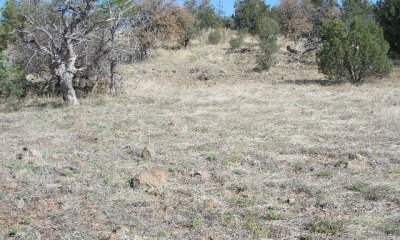
Volcanic Hills 20-24"
Scenario model
Current ecosystem state
Select a state
Management practices/drivers
Select a transition or restoration pathway
- Transition 1a More details
- Transition 1b More details
- Transition 2a More details
- Restoration pathway 3a More details
- Restoration pathway 3b More details
-
No transition or restoration pathway between the selected states has been described
Target ecosystem state
Select a state
Description
Grass, shrubs, and trees are all represented in the Reference State.
Submodel
Description
Midgrasses have been replaced by short grasses.
Submodel
Mechanism
High intensity continuous herbivory by livestock or wildlife reduces the vigor and abundance of sideoats grama and increases the abundance of short grasses like blue grama on cool aspects or hairy grama on warm aspects. Horses being more apt to use steeper slopes can have equally detrimental effects.
Mechanism
Absence of fires for very long periods allows tree regeneration to grow to maturity, increase in size, and dominate the site.
Mechanism
Absence of fires for very long periods allows tree regeneration to grow to maturity, increase in size, and dominate the site.
Mechanism
This restoration pathway is an assumption and needs additional investigation. Areas with 80-90% tree canopy have been observed with mid grass densities of 5-10 plants per square yard. Extreme wildfire is the only practical way to reduce tree abundance. Brush management applied to similar wooded environments with similar grass plant densities in LRU 38-3 has demonstrated favorable responses in grass production where range planting was unnecessary.
This restoration is only practical where there is remnant mid grasses in tree interspaces and they are not destroyed by fire. Aerial range planting is the only practical seeding method and may be required in the event of high grass mortality.
Mechanism
This restoration pathway is an assumption and needs additional investigation. Areas with 80-90% tree canopy have been observed with short grass densities of 5-10 plants per square yard. Extreme wildfire is the only practical way to reduce tree abundance. Brush management applied to similar wooded environments with similar grass plant densities in LRU 38-3 has demonstrated favorable responses in grass production where range planting was unnecessary.
This restoration is only practical where there is remnant short grasses in tree interspaces and they are not destroyed by fire. Aerial range planting is the only practical seeding method and may be required in the event of high grass mortality.
Model keys
Briefcase
Add ecological sites and Major Land Resource Areas to your briefcase by clicking on the briefcase (![]() ) icon wherever it occurs. Drag and drop items to reorder. Cookies are used to store briefcase items between browsing sessions. Because of this, the number of items that can be added to your briefcase is limited, and briefcase items added on one device and browser cannot be accessed from another device or browser. Users who do not wish to place cookies on their devices should not use the briefcase tool. Briefcase cookies serve no other purpose than described here and are deleted whenever browsing history is cleared.
) icon wherever it occurs. Drag and drop items to reorder. Cookies are used to store briefcase items between browsing sessions. Because of this, the number of items that can be added to your briefcase is limited, and briefcase items added on one device and browser cannot be accessed from another device or browser. Users who do not wish to place cookies on their devices should not use the briefcase tool. Briefcase cookies serve no other purpose than described here and are deleted whenever browsing history is cleared.
Ecological sites
Major Land Resource Areas
The Ecosystem Dynamics Interpretive Tool is an information system framework developed by the USDA-ARS Jornada Experimental Range, USDA Natural Resources Conservation Service, and New Mexico State University.




